New Delhi: The global PC market climbed 12.7 per cent from a year ago to reach 79.2 million units in the third quarter of this year, registering the highest growth the market has seen in the past 10 years, according to the latest report from Canalys.
After a weak Q1, the recovery in Q2 continued into Q3 this year in which Lenovo regained the top spot, showed data released by the analyst company.
Global notebook shipments touched 64 million units — almost as much as the record high of Q4 2011 when notebook shipments were 64.6 million — as demand continued to surge due to second waves of Covid-19 in many countries and companies continued to invest in longer-term transitions to remote working.
Shipments of notebooks and mobile workstations grew 28.3 per cent year-on-year. This contrasted with desktop and desktop workstations, which saw shipments shrink by 26 per cent.
“Vendors, the supply chain, and the channel have now had time to find their feet and allocate resources towards supplying notebooks, which continue to see massive demand from both businesses and consumers,” Ishan Dutt, Canalys Analyst, said in a statement.
“After prioritizing high-value markets and large customers in Q2, vendors have now been able to turn their attention to supplying a wider range of countries as well as SMBs that faced difficulty securing devices earlier this year.”
Lenovo regained top spot in the PC market in Q3 with growth of 11.4 per cent and shipments surpassed the 19 million mark, helping it capture 24.3 per cent market share.
HP posted a similarly impressive growth of 11.9 per cent to secure second place with 18.7 million units shipped, capturing 23.6 per cent market share.
Dell, in third, suffered a small decline of 0.5 per cent in shipments from a year ago as its market share reached 15.1 per cent.
Apple and Acer rounded out the top five rankings, posting stellar growth of 13.2 per cent and 15 per cent respectively.
Apple’s market share stands at 8.1 per cent and Acer’s at 7.1 per cent in Q3, according to the report.
“Governments, which have realised the importance of PC access in maintaining economic activity during this time, have intervened with financial support or even full-scale device deployments,” Dutt said.
“This has been especially critical in the education space, with school terms commencing in Q3 without the possibility of on-premises learning in many markets. For example, the UK government made 100,000 notebooks available to ensure students, unable to return to classrooms, face minimum disruption in their ability to receive an education.”
IT expenditure, including investment in PCs, is expected to be a core driver of economic recoveries in the aftermath of the pandemic, according to Canalys.




